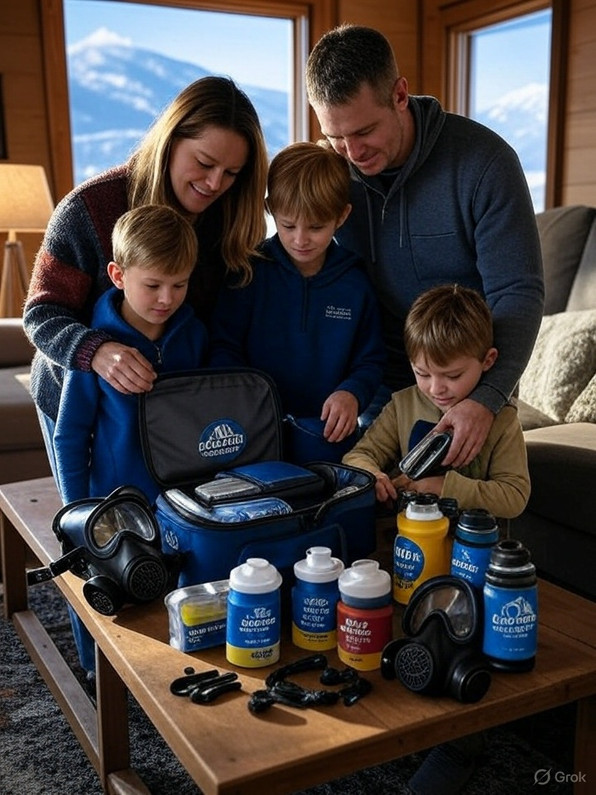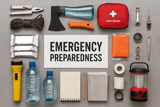Building Your Ultimate Emergency Preparedness Kit: A Step-by-Step Guide for Canadians
In Canada, being prepared for the unexpected is more than a precaution—it’s a necessity. From harsh winters and wildfires to remote outdoor adventures or rising urban safety concerns, having a well-stocked emergency preparedness kit can make all the difference. At Civil Safety, we’re committed to helping Canadians take charge of their safety with high-quality survival and emergency gear. Follow this step-by-step guide to build your ultimate emergency kit, tailored for Canadian families, outdoorsmen, and first responders.
Step 1: Assess Your Needs
Every emergency kit should reflect your unique circumstances. Consider where you live and the scenarios you might face:
- Urban residents: Focus on evacuation needs, like portable gear for sudden emergencies or civil unrest.
- Rural or remote dwellers: Prioritize self-sufficiency with navigation tools and long-lasting supplies.
- Outdoor enthusiasts: Emphasize lightweight, durable gear for wilderness survival.
- Families: Include supplies for all members, including children or pets.
Think about potential risks like power outages, floods, or extreme weather. A solid kit covers 72 hours of self-reliance, but longer-term preparedness is ideal for remote areas.
Step 2: Essential Categories for Your Kit
A comprehensive emergency kit includes supplies across several key categories. Here’s what to include, with recommendations from our in-stock products at Civil Safety:
First Aid
Medical emergencies don’t wait for help to arrive. A reliable first aid kit is non-negotiable.
- Adventure Medical Kits Mountain Series Day Tripper Lite ($36.99): Compact and lightweight, this kit is perfect for day trips or as a core component of a home kit. It includes essentials like bandages, antiseptics, and trauma supplies for minor injuries.
- Eleven 10 RIGID TQ Case for C-A-T ($37.99): For serious bleeding, pair this tourniquet case with a Combat Application Tourniquet (sold separately) to ensure rapid access in critical situations.
Hydration
You can survive only three days without water, so hydration is critical.
- CamelBak Eddy+ 25oz Bottle ($29.99): Durable and leak-proof, this bottle is ideal for everyday use or emergency hydration. Its BPA-free design ensures safe, clean water storage.
- For larger groups or extended emergencies, consider a hydration reservoir like the CamelBak Mil-Spec Crux 3L Reservoir ($59.99), which fits in backpacks for hands-free water access.
Navigation
Getting lost in Canada’s vast wilderness or urban chaos can be deadly. Reliable navigation tools keep you oriented.
- Silva Starter 1-2-3 Compass ($19.99): Simple and affordable, this compass is perfect for beginners or as a backup for experienced adventurers.
- Silva Ranger 2.0 Compass ($55.99): For advanced navigation, this compass offers precision and durability, ideal for backcountry trips.
Protection
Personal safety is paramount, whether from environmental hazards or security threats.
- MIRA Safety CM-6M Tactical Gas Mask (Price varies): Protect against chemical, biological, or smoke hazards with this professional-grade gas mask. Pair it with in-stock MIRA Safety NBC-77 SOF Filter for comprehensive CBRN protection.
- Faraday Defense NX3-2 Faraday Bag ($49.99): Safeguard electronics from EMP or hacking with this compact Faraday bag, perfect for protecting phones or radios.
Hygiene
Maintaining hygiene prevents illness in emergencies, especially in crowded or outdoor settings.
- Adventure Ready Outdoor Shower ($43.99): This portable shower ensures cleanliness in the field, with a 10L capacity for multiple uses.
- Scrubzz Disposable Rinse Free Bath Sponge ($13.99): These no-rinse sponges are a lightweight, mess-free solution for personal hygiene when water is scarce.
Step 3: Choosing Quality Gear
Investing in high-quality gear ensures your kit performs when it matters most. At Civil Safety, we stock trusted brands like CamelBak, MIRA Safety, and Silva, known for durability and reliability. Cheap alternatives may fail under stress, so prioritize products designed for real-world conditions. For example, the CamelBak Mil-Spec Crux Reservoir is built to military standards, ensuring it won’t leak or break during tough missions.
When selecting gear, consider:
- Durability: Will it withstand harsh Canadian weather or rugged terrain?
- Portability: Can you carry it easily during an evacuation or outdoor trek?
- Ease of Use: Is it intuitive for all family members, including kids or seniors?
Step 4: Storage and Maintenance
A great kit is useless if it’s disorganized or outdated. Follow these tips to keep it ready:
- Storage: Store your kit in a waterproof, accessible container like a backpack or sealed bin. Keep it in a cool, dry place, like a closet or garage, but ensure it’s easy to grab in a hurry.
- Organization: Use pouches or compartments to separate items by category (e.g., medical, hydration). The First Tactical Tactix 3x6 Utility Pouch ($39.99) is great for organizing smaller items within your kit.
- Maintenance: Check your kit every six months. Replace expired items (e.g., medications, food), test electronics, and update supplies based on changing needs (e.g., new family members).
Conclusion: Start Small, Stay Prepared
Building an emergency preparedness kit doesn’t have to be overwhelming. Start with the essentials—first aid, hydration, navigation, protection, and hygiene—and expand as needed. At Civil Safety, we’re here to support you with top-quality gear from brands like Adventure Medical Kits, CamelBak, and MIRA Safety, all ready to ship across Canada.
Don’t wait for a crisis to act. Explore our Medical, Outdoors, and Protection collections today to stock your kit. Have your own preparedness tips? Share them in the comments below, or download our free emergency kit checklist [insert link if you create one] to get started. Prepare today to live tomorrow
Recent Posts
-
Civil Safety Renews Business Membership with the Canadian Coalition for Firearm Rights (CCFR)
At Civil Safety, our mission is clear: to empower Canadians to take personal responsibility for thei …20th Nov 2025 -
Prepare Today, Thrive Tomorrow: Why Every Canadian Needs a Reliable Emergency Kit
As Canadians, we’re no strangers to unpredictable weather, remote adventures, and the occasional eme …5th Sep 2025 -
Building Your Ultimate Emergency Preparedness Kit: A Step-by-Step Guide for Canadians
In Canada, being prepared for the unexpected is more than a precaution—it’s a necessity. From harsh …10th Jun 2025




